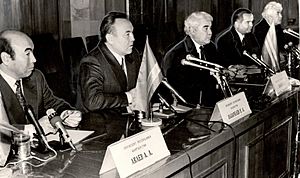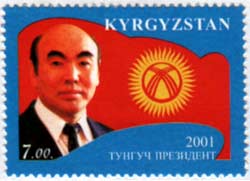Askar Akayev facts for kids
Quick facts for kids
Askar Akayev
|
|
|---|---|
|
Аскар Акаев
|
|
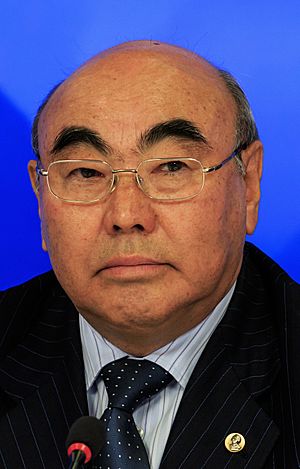
Akayev in 2016
|
|
| 1st President of Kyrgyzstan | |
| In office 27 October 1990 – 24 March 2005 |
|
| Prime Minister | Nasirdin Isanov Andrei Iordan (acting) Tursunbek Chyngyshev Almanbet Matubraimov (acting) Apas Jumagulov Kubanychbek Jumaliyev Boris Silayev (acting) Jumabek Ibraimov Boris Silayev (acting) Amangeldy Muraliyev Kurmanbek Bakiyev Nikolai Tanayev |
| Vice President | Nasirdin Isanov German Kuznetsov Feliks Kulov |
| Preceded by | Position established |
| Succeeded by | Ishenbai Kadyrbekov (Acting) |
| Personal details | |
| Born | 10 November 1944 Kyzyl-Bayrak, Kirghiz SSR, Soviet Union (now Kyrgyzstan) |
| Political party | Independent Forward Kyrgyzstan Party (affiliated) |
| Spouse | Mayram Akayeva |
| Children | 4, including Bermet and Aidar |
| Residences | Moscow, Russia |
| Signature |  |
Askar Akayev was a politician from Kyrgyzstan. He served as the first President of Kyrgyzstan from 1990 until March 2005. He left office during a time of public protests.
Contents
Early Life and Education
Askar Akayev was born on November 10, 1944, in a village called Kyzyl-Bayrak, which was then part of the Kirghiz Soviet Socialist Republic. He was the oldest of five sons in a family of farmers.
In 1961, he started working as a metalworker. Later, he moved to Saint Petersburg (then called Leningrad) to study physics. He graduated in 1967 with high honors in mathematics, engineering, and computer science. He continued to work and teach at the institute until 1976.
In 1970, he married Mayram Akayeva in Leningrad. They later had two sons and two daughters. In 1977, they moved back to Kyrgyzstan, where he became a senior professor at the Frunze Polytechnic Institute. Some of his future government members were his former students or friends from his time as a professor.
In 1981, he earned a higher degree (a doctorate) from the Moscow Institute of Engineering and Physics. He became a member of the Kyrgyz Academy of Sciences in 1984. He then became the vice president of the academy in 1987 and its president in 1989. In the same year, he was also chosen as a representative in the Supreme Soviet of the USSR.
Becoming President
On October 25, 1990, the Kirghiz SSR's Supreme Soviet held an election for the new position of president. Two candidates ran, but neither received enough votes. Because of this, both candidates were disqualified.
Two days later, on October 27, the Supreme Soviet chose Askar Akayev to be the first president. He was a compromise candidate, meaning he was someone everyone could agree on. In 1991, he was offered a high position as vice-president of the Soviet Union by President Mikhail Gorbachev, but he did not accept it.
Akayev was officially elected president of the newly named Republic of Kyrgyzstan on October 12, 1991. He ran without any opponents in that election. He was reelected two more times, in 1995 and 2000. However, there were some claims that these elections were not completely fair.
Akayev was first seen as a leader who supported free markets and open government. He once said that he believed in private property and that economic progress came from ideas like those of Adam Smith. He encouraged private ownership of land and other businesses. His government was also more open compared to other countries in Central Asia. In 2003, the parliament gave him lifelong protection from being charged with crimes.
Public Protests
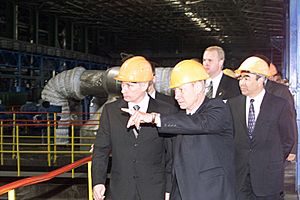
In March 2002, the first major protests against Akayev's government began. People gathered in Jalal-Abad to support a member of parliament who was on trial. During these protests, police and demonstrators clashed, and some people were killed or injured.
More protests happened in Bishkek in May 2002. Police tried to break up crowds of people who were asking for Akayev to resign. Protests continued in the following years, though sometimes on a smaller scale.
End of Presidency
On March 24, 2005, many protesters gathered in the main square of Bishkek. They entered the presidential building and took control of it after clashing with police. People in other cities in the south also took control of towns, demanding that Akayev step down.
On that day, Akayev and his family left Kyrgyzstan. He reportedly went to Kazakhstan first, then to Russia. The Russian president, Vladimir Putin, invited Akayev to stay in Russia.
Akayev officially resigned on April 4, 2005, when members of the Kyrgyz parliament met him in Russia. The Kyrgyz Parliament accepted his resignation on April 11, 2005. They also removed special benefits that had been given to him and his family by the previous parliament. He was also no longer called the "First President of Kyrgyzstan."
Life After Presidency
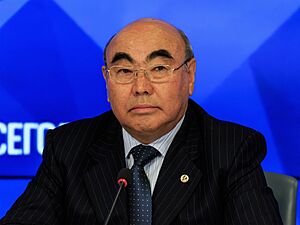
Today, Askar Akayev works as a professor and researcher at Moscow State University in Russia. He is involved in programs that study complex systems and world dynamics. He also supervises a center that analyzes stability and risk at the HSE University in Moscow.
In July 2021, Akayev was part of an investigation related to operations at the Kumtor Gold Mine. The next month, he returned to Bishkek for the first time in 16 years to help with the investigation. He thanked President Sadyr Japarov for allowing him to return. In December 2021, the investigation was closed.
In August 2023, Akayev spoke in an interview about the conflict between Russia and Ukraine. He said that Kyrgyzstan, as an ally of Russia, should support Russia. He explained that allies are especially important during difficult times.
Awards and Recognition
Askar Akayev has received several honors:
- From Slovakia: The Grand Cross of the Order of the White Double Cross (2003).
- In 2012, he received the Gold Kondratieff Medal from the International N. D. Kondratieff Foundation.
- From Kazakhstan: The Order of Dostyk (2001).
See also
 In Spanish: Askar Akáyev para niños
In Spanish: Askar Akáyev para niños
- Politics of Kyrgyzstan


